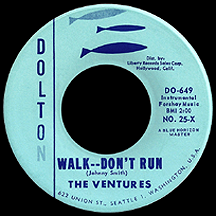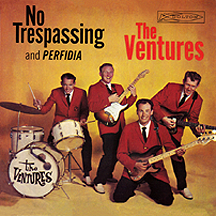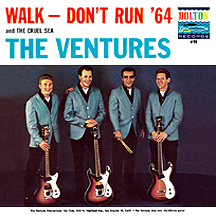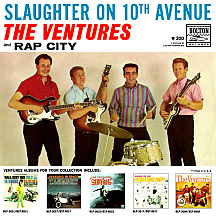THE VENTURES
In the 1960s, a wildly popular rock band called The Ventures built its reputation sans vocals. Like a number of other acts from the era, each of the group's hits was an instrumental, a bygone practice that makes the last few decades that much less interesting due to the absence of anything comparable. But I want to set the record straight on one thing: they primarily recorded other artists' material. You can call them a cover band if you like, albeit a very creative one. Any originality the group had was usually not in choice of material, rather in the interpretation of that material, as they often took an established song and transformed it into something fresh and exciting.
Bob Bogle grew up in Portland, Oregon and in the late 1950s was working for a construction company in Tacoma, Washington, about 150 miles north of Portland. Don Wilson's father owned a used car dealership in Tacoma, and the two met when Bogle came in one day to buy a car. Conversation quickly shifted to talk of music and the interest both had in guitar playing, and before long they were practicing together and then playing small clubs in the area. Bogle was lead guitarist and Wilson handled rhythm, sometimes joined by other musicians, and though they mostly played instrumentals, Wilson would occasionally sing. When George Babbitt joined as drummer, they felt they were "venturing" into a new line of work, so the newly-christened Ventures made a demo tape...which Seattle label Dolton Records rejected, in part because they already had a similar group, The Frantics, under contract. So the guys went ahead and pressed a single on their own label, Blue Horizon, called "Cookies and Coke," a vocal effort recorded at Boles Studio in Seattle, a basement operation run by Joe Boles. The unpolished vocal quality of the record demonstrated the need for the three to focus on honing their instrumental skills.
Jazz guitarist Johnny Smith recorded an instrumental called "Walk, Don't Run!" for Blue Note in 1954 (Smith has said he got the title from a sign he saw in a New York subway), and four years later the great country guitarist Chet Atkins offered his finger-pickin' interpretation of the song on the album "Hi-Fi in Focus." Bob Bogle liked Chet's version and the group chose to adapt it, rock-style (with a much different arrangement), as their second Blue Horizon effort. Nokie Edwards joined as bass player and Howie Johnson completed the lineup as drummer when Babbitt, only 17 in 1959, decided to quit. Recorded in Boles' basement in two-track stereo, "Walk - Don't Run" was an instant smash, right? Not so fast! After a brief time when it appeared to be headed toward the same fate as the first single, the guys took the single to a disc jockey they knew at KJR, Seattle's top-rated top 40 station at the time. Hesitant, the station agreed to play it as a lead-in to news segments, meaning the track might receive only a half-minute of exposure. But it was enough: "What was that...?" calls from listeners for the unannounced clip was strong and the station began playing the full song in regular rotation. Dolton showed some interest in distributing the record nationally, hesitant at first to pit them against their own Frantics, but that attitude changed when the song took off, going as high as number 2 on the national charts in August 1960.
Don, Bob, Nokie and Howie reached back further in time for the follow-up, "Perfidia," the Alberto Dominguez composition that had been a hit for Xavier Cugat in 1941, and their rock rendition went top 20. With the flip side, they used Johnny Smith's idea, titling their original tune "No Trespassing" after seeing a sign on someone's private property. Next came "Ram-Bunk-Shush" (a 1957 R&B hit for Hammond organist Bill Doggett), then it was back to Atkins' "Hi-Fi in Focus" album for "Lullaby of the Leaves," recycling the arrangement of "Walk - Don't Run." With each single charting lower than the last, the group focused their energies on making albums, releasing as many as four per year, chock full of instrumental versions of the latest hits. More than 30 were released between 1960 and 1969, a nonstop string of top-selling LPs.
In 1962 and '63 the group was hitting the charts with movie music like "(Theme from) Silver City" and "Lolita Ya-Ya" from the Stanley Kubrick film Lolita (featuring seldom-heard vocals on a Ventures record, a female chorus chanting 'yeah, yeah' almost identical to a version released by the film's star, Sue Lyon). Due to complications from an auto accident several years earlier, Johnson left the band in 1962, replaced on drums by Mel Taylor, a house drummer the guys had met at the Palomino Club, a popular country music venue in North Hollywood, California. This same year they toured Japan for the first time, sparking a sensational public reaction later termed "Venturemania." Scoring hits in many countries around the globe over the years, nothing came close to the tremendous and unexpected popularity they had in Japan, where countless young groups existed for the sole purpose of playing Ventures songs (and not having to worry about learning any English lyrics, or worse yet, attempting to translate those lyrics). Record sales there were strong and steady, rivaling the band's success in the United States.
The axe of choice for the group was the Fender guitar (particularly the Stratocaster, Jazzmaster and more recent sensation, Fender's Precision Bass), but for a time they exclusively played Mosrite guitars (due to a lucrative promotional deal they signed with Semie Moseley, founder of the Mosrite company), returning to their Fenders when the terms of the contract expired. Bogle and Edwards began trading off lead guitar and bass playing roles (Edwards eventually taking over as lead guitarist), experimenting with studio effects, including a "fuzz tone" distortion sound (possible with a Mosrite Fuzzrite pedal) on "The 2,000 Pound Bee," a two-part original with split writer credits: Taylor on side one, Wilson on side two.
They released a few 45s penned by group members, including "Yellow Jacket," "Instant Mashed" and "Skip to M'Limbo," but none of these were big hits. Los Angeles-area surf band The Lively Ones scored a minor west coast hit in 1963 with a Ventures album cut, Nokie Edwards' "Spudnik," retitling it "Surf Rider" and claiming songwriter credit, generating a temporary royalty dispute. With surf music the rage that year, it became clear that The Ventures, with no singles in the top 40 since 1961, should contribute surf stylings of their own. "The Ninth Wave," another original, didn't connect, so they tried something that had been done many times before without success - they revamped their biggest hit in an attempt to score with it a second time. The odds were against "Walk - Don't Run '64," a mid-tempo version with a surf arrangement, but it sounded cool on the radio and made the grade, going top ten in August, exactly four years after the original established them as a hit act. Going top ten twice with different recordings of the same song is highly unusual for an artist: Bing Crosby had pulled it off previously with a 1947 re-recording of the number one 1942 hit "White Christmas," Neil Sedaka achieved the feat later with a 1975 ballad version of his 1962 smash "Breaking Up is Hard To Do," and it's happened since for Dobie Gray, but remains a rarity.
As the '60s progressed, The Ventures never strayed far from what they did best: adapting music from other sources, or performing guitar-based covers of current hits. Certainly the most bizarre of these was a 1966 cover of The Troggs' "Wild Thing," with a Peter Lorre impressionist taking the spoken vocals to a heavy-breathing, creepy new level. They applied their trademark style to movie and TV themes, including "Slaughter on Tenth Avenue," "Secret Agent Man," "Blue Star" (from Medic), "The Green Hornet," "The Wild Angels" and even Bruce Brown's most notable documentary on surfing, "The Endless Summer."
Nokie Edwards left the group in 1968 (no doubt well-set financially by this time) and was replaced by lead guitarist Gerry McGee, as the band was developing a harder rock sound in keeping with the trends of the late 1960s. The albums kept selling, but there hadn't been a major hit single since '64. A break came in 1968 when the group was approached to record the theme for a new police show starring Jack Lord, "Hawaii Five-O," written by Mort Stevens, who also scored music for the series. This time around the group wasn't doing someone else's hit, it was theirs! The show debuted on CBS in the fall of '68 and stayed on the air until 1980, one of the longest-running cop shows ever. The theme song by The Ventures, now on Dolton parent label Liberty, took the song to the top ten in May 1969. As record sales fell off in the 1970s, the band ventured on, performing live shows with varying lineups, including Wilson, Bogle and Edwards much of the time. The Japanese continued their obsession with the group, and in America, what can I say? Ventures is the last word in instrumental rock bands!
NOTABLE SINGLES:
- Walk - Don't Run - 1960
- Perfidia /
No Trespassing - 1960 - Ram-Bunk-Shush - 1961
- Lullaby of the Leaves /
Ginchy - 1961 - (Theme from) Silver City - 1961
- Blue Moon - 1961
- Instant Mashed - 1962
- Lolita Ya-Ya - 1962
- The 2,000 Pound Bee - 1963
- Skip to M'Limbo - 1963
- The Ninth Wave - 1963
- Fugitive - 1964
- Walk - Don't Run '64 - 1964
- Slaughter on Tenth Avenue /
Rap City - 1964 - Diamond Head - 1965
- Secret Agent Man - 1966
- Blue Star - 1966
- Green Hornet Theme - 1966
- Wild Thing - 1966
- (Theme from) The Wild Angels - 1966
- (Theme from) Endless Summer - 1967
- Hawaii Five-O - 1969
- (Theme from) A Summer Place - 1969





